Submarine fault scarps in the Sea of Marmara pull-apart ... - HAL - IRD
Submarine fault scarps in the Sea of Marmara pull-apart ... - HAL - IRD
Submarine fault scarps in the Sea of Marmara pull-apart ... - HAL - IRD
You also want an ePaper? Increase the reach of your titles
YUMPU automatically turns print PDFs into web optimized ePapers that Google loves.
Geochemistry<br />
Geophysics<br />
Geosystems G 3<br />
G 3 armijo et al.: sea <strong>of</strong> marmara <strong>pull</strong>-<strong>apart</strong> 10.1029/2004GC000896<br />
Figure 6. <strong>Submar<strong>in</strong>e</strong> <strong>scarps</strong> <strong>in</strong> <strong>the</strong> Central Bas<strong>in</strong> compared with similar <strong>scarps</strong> on land near Eften lake extensional<br />
step-over. (a) Side-scan sonar image (illum<strong>in</strong>ated from <strong>the</strong> SE) <strong>of</strong> large en echelon <strong>scarps</strong> with normal and rightlateral<br />
strike-slip components on <strong>the</strong> SW boundary <strong>fault</strong> <strong>of</strong> <strong>the</strong> <strong>in</strong>ner Central Bas<strong>in</strong> <strong>pull</strong>-<strong>apart</strong> (compare with Figures 4<br />
and 5). (b) Scarps with similar features but substantially smaller near <strong>the</strong> western term<strong>in</strong>ation <strong>of</strong> <strong>the</strong> 12 November<br />
1999 Duzce earthquake rupture (Mw 7.2). Individual <strong>scarps</strong> with free faces 20–50 cm high associated with <strong>the</strong> Duzce<br />
earthquake lacerate obliquely a cumulative normal <strong>fault</strong> scarp 4 m high. The <strong>in</strong>let provid<strong>in</strong>g water to <strong>the</strong> pool has<br />
been right-laterally <strong>of</strong>fset 1.5 m across <strong>in</strong>dividual <strong>fault</strong> scarp at <strong>the</strong> very base <strong>of</strong> <strong>the</strong> cumulative scarp. Total normal<br />
and strike <strong>of</strong>fsets reached 4 m <strong>in</strong> 1999 <strong>in</strong> <strong>the</strong> Eften area [Akyüz et al., 2002].<br />
along strike, attest<strong>in</strong>g that <strong>the</strong>re is no systematic<br />
vertical <strong>of</strong>fset <strong>of</strong> <strong>the</strong> morphology; thus <strong>the</strong> prevail<strong>in</strong>g<br />
motion across <strong>the</strong> <strong>fault</strong> is strike-slip.<br />
[26] The most outstand<strong>in</strong>g feature is <strong>the</strong> cont<strong>in</strong>uity<br />
and <strong>the</strong> l<strong>in</strong>earity <strong>of</strong> a set <strong>of</strong> <strong>scarps</strong> that are <strong>in</strong> many<br />
places less than 0.5 m high (less than one contour<br />
l<strong>in</strong>e <strong>in</strong> <strong>the</strong> microbathymetry map; Figure 7). This<br />
set <strong>of</strong> cont<strong>in</strong>uous <strong>in</strong>dividual <strong>scarps</strong> comes <strong>in</strong>to<br />
sight <strong>in</strong> <strong>the</strong> microbathymetry as a sharp cut made<br />
<strong>in</strong>to <strong>the</strong> s<strong>of</strong>t sediments cover<strong>in</strong>g <strong>the</strong> smooth topography<br />
<strong>of</strong> <strong>the</strong> Western High. Visual <strong>in</strong>spection with<br />
<strong>the</strong> ROV proved that <strong>the</strong> small-scale <strong>scarps</strong> are<br />
mantled with a drape <strong>of</strong> s<strong>of</strong>t pelagic sediments and<br />
Figure 7. Morphology <strong>of</strong> EW-strik<strong>in</strong>g, purely strike-slip <strong>fault</strong> <strong>scarps</strong> across <strong>the</strong> Western High. (a) Microbathymetry<br />
(top) and correspond<strong>in</strong>g side-scan sonar image (bottom) show smooth sea-bottom morphology disrupted by a sharp,<br />
cont<strong>in</strong>uous break along <strong>the</strong> l<strong>in</strong>ear <strong>fault</strong> trace (outl<strong>in</strong>ed by red arrows). Disruption <strong>of</strong> morphology occurs at various<br />
scales with opposite north- and south-fac<strong>in</strong>g vertical <strong>of</strong>fsets suggest<strong>in</strong>g prevail<strong>in</strong>g strike-slip. Pressure ridges and<br />
<strong>pull</strong>-<strong>apart</strong> ponds can be seen (examples identified). Contours each 0.5 m. (b) Enlargement <strong>of</strong> shallowest area (box <strong>in</strong><br />
Figure 7a), where sea-bottom landforms are clearly <strong>of</strong>fset laterally. (c) Restor<strong>in</strong>g <strong>of</strong>fsets <strong>of</strong> <strong>in</strong>dividual scarp requires<br />
6 ± 1 m <strong>of</strong> right-lateral slip, which could result mostly from rupture <strong>of</strong> a large earthquake.<br />
14 <strong>of</strong> 29




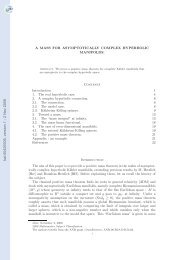


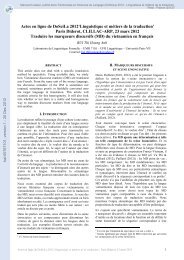
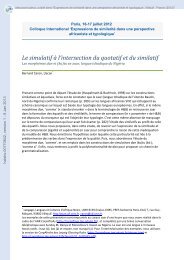
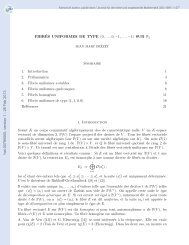
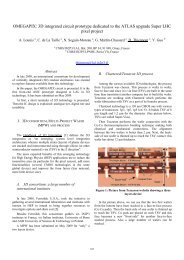
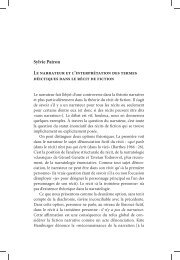
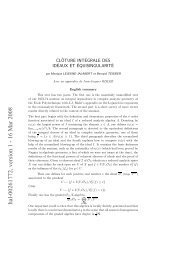
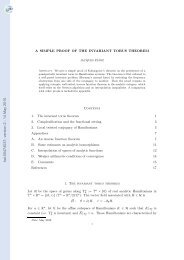

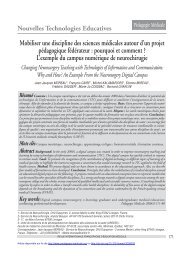

![[tel-00433556, v1] Relation entre Stress Oxydant et Homéostasie ...](https://img.yumpu.com/19233319/1/184x260/tel-00433556-v1-relation-entre-stress-oxydant-et-homeostasie-.jpg?quality=85)